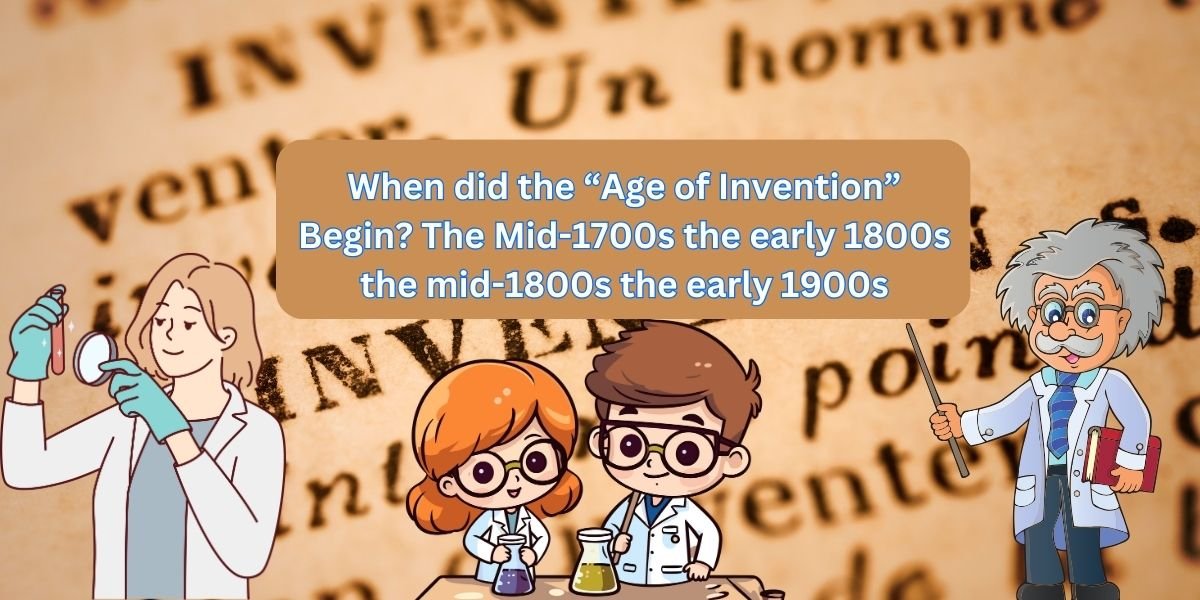The term “Age of Invention” refers to a period in history marked by profound technological advancements that transformed societies worldwide. But When did the “Age of Invention” Begin? The Mid-1700s the early 1800s the mid-1800s the early 1900s? This is a question that has intrigued historians and scholars for years. In this article, we will dive deep into the origins of this era of innovation, explore the key milestones, and try to determine when this transformative period truly began.
Overview of the Age of Invention
The Age of Invention is often considered a time when technological breakthroughs radically changed the course of human history. During this period, inventors and engineers developed devices and concepts that revolutionized various industries, including manufacturing, transportation, communication, and medicine. These innovations helped shape the modern world as we know it today.
However, pinpointing exactly when the “Age of Invention” began is no easy task. Was it the mid-1700s, when the Industrial Revolution gained momentum? Or did it start in the early 1800s, with rapid advancements in steam power and transportation? Could it have been the mid-1800s, with the introduction of electrical devices? Or perhaps the early 1900s, with the rise of the automobile, airplane, and radio? Let’s explore these periods more closely.
Read Also: Ronnie Coleman After Bodybuilding / Wordiply Today
The Mid-1700s: The Dawn of Industrialization

The mid-1700s is often seen as the starting point of the Age of Invention, with the onset of the Industrial Revolution. This period witnessed profound changes in the way people lived and worked, as inventions such as the steam engine helped mechanize labor.
Key Inventions of the Mid-1700s
Several inventions from this era marked the beginning of the Age of Invention:
- Steam Engine (1712): Invented by Thomas Newcomen, this engine used steam to power machines and was a catalyst for industrialization.
- Spinning Jenny (1764): This device, developed by James Hargreaves, revolutionized the textile industry by allowing multiple threads to be spun simultaneously.
- Water Frame (1769): Invented by Richard Arkwright, this machine harnessed water power to automate the spinning process.
The mid-1700s laid the foundation for modern industrial societies, which is why many historians argue that this is when the “Age of Invention” began.
The Early 1800s: The Rise of Steam Power and Communication
The early 1800s saw an acceleration in technological advancements, as inventors refined earlier inventions and introduced new technologies that significantly impacted daily life and industry.
Key Inventions of the Early 1800s
- Locomotives (early 1800s): George Stephenson invented the first steam-powered locomotive, which revolutionized transportation and fueled the expansion of the railway system.
- Telegraph (1837): Samuel Morse invented the telegraph, making it possible to send messages over long distances via electrical signals.
- Vaccination (1796): Edward Jenner developed the smallpox vaccine, revolutionizing medicine and laying the groundwork for future breakthroughs.
This period of innovation highlights the growing importance of steam power and communication technologies, making the early 1800s another significant period for the “Age of Invention”.
The Mid-1800s: Electrical and Mechanical Marvels
The mid-1800s saw significant developments in electricity and mechanical engineering. During this period, inventors applied scientific principles to create technologies that transformed industries, including the rise of the electric telegraph, electric generators, and more efficient manufacturing machines.
Key Inventions of the Mid-1800s
- Electric Telegraph (1837): The electric telegraph revolutionized long-distance communication, connecting people across vast distances.
- Electric Generator (1866): Michael Faraday discovered the principle of electromagnetic induction, which eventually led to the creation of electric generators.
- Sewing Machine (1846): Invented by Elias Howe and improved by Isaac Singer, the sewing machine revolutionized the textile industry and mass production.
The mid-1800s ushered in an era where electricity became central to technological progress, adding another layer of innovation to the “Age of Invention”.
Read Also: TamilYogi / Airtel Enterprise Hub Login / RSETI Login
The Early 1900s: A Surge of Innovation

By the early 1900s, the world was undergoing dramatic changes due to technological advancements. The Age of Invention reached its peak during this time, with inventions such as the automobile, airplane, and radio transforming how people lived, worked, and communicated.
Key Inventions of the Early 1900s
- Airplane (1903): Orville and Wilbur Wright achieved the first successful powered flight, forever changing transportation.
- Automobile (1908): Henry Ford revolutionized the automobile industry by introducing the assembly line, making cars affordable for the masses.
- Radio (1906): Guglielmo Marconi developed the radio, which allowed for wireless communication over long distances.
- Refrigerator (1913): The home refrigerator invented by Fred W. Wolf allowed people to preserve food for longer periods.
With these innovations, the early 1900s marked the culmination of the Age of Invention.
The Role of Inventors in the Age of Invention
The Age of Invention is inextricably linked to the work of brilliant inventors who developed the technologies that defined this era. These inventors were visionaries who changed the course of history by creating devices that revolutionized industries and societies.
Notable Inventors and Their Contributions
- Thomas Edison: Famous for inventing the light bulb and the phonograph, Edison’s innovations improved the quality of life for millions of people.
- Nikola Tesla: Tesla’s work on alternating current (AC) power transmission became the foundation of modern electrical systems.
- Alexander Graham Bell: Invented the telephone, making long-distance communication easier and more accessible.
- Henry Ford: Revolutionized the manufacturing industry with the invention of the assembly line, making cars affordable and accessible to the general population.
These inventors played crucial roles in shaping the course of the Age of Invention, and their contributions are still felt today.
Read Also: kfcsc.kar.nic.in | kfcsc Login |
Key Periods of the Age of Invention
When considering the question “when did the Age of Invention begin?”, we can look at the key periods of innovation that spanned from the mid-1700s to the early 1900s.
- Mid-1700s to Early 1800s: The onset of the Industrial Revolution marked the early days of the Age of Invention, particularly with the development of steam power and mechanized labor.
- Early to Mid-1800s: The rise of electricity, the telegraph, and advancements in manufacturing signaled the growing influence of technology during this period.
- Early 1900s: The rapid innovations in transportation, communication, and consumer products made the early 1900s the height of the Age of Invention.
Global Impact of the Age of Invention
The innovations that emerged during the Age of Invention had far-reaching effects on global society. They not only transformed industries but also changed the way people lived, interacted, and connected across the globe.
Economic Growth and Global Expansion
The technological advancements of the Age of Invention spurred economic growth, particularly in industrialized nations. The rise of manufacturing industries, fueled by inventions like the steam engine and assembly line, created new jobs and fostered economic expansion.
Social Change
The Age of Invention also led to significant social change. As people moved from rural areas to cities in search of work, urbanization became a key feature of the industrialized world. Moreover, new classes emerged, and labor unions were formed to fight for workers’ rights.
Conclusion: When Did the “Age of Invention” Begin?
In answering the question, “when did the ‘Age of Invention’ begin?”, it becomes clear that this period of rapid technological advancement did not have a single point of origin. While many would argue that the mid-1700s, with the rise of the Industrial Revolution, marked the beginning of the Age of Invention, others point to the early 1800s or the early 1900s as key milestones.
Ultimately, the Age of Invention was shaped by numerous breakthroughs over a span of several centuries. From the mid-1700s to the early 1900s, these innovations transformed societies and laid the foundation for the modern world. The “Age of Invention” is a testament to human ingenuity and the ability to shape our future through innovation.




